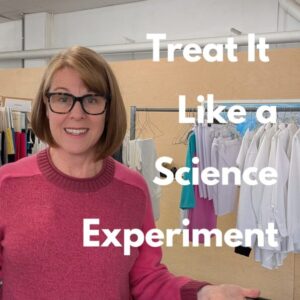Why Fashion Development Is Just Like a Science Experiment

If you’ve ever tried baking a new recipe and swapped too many ingredients, you’ll know how wrong things can go. Flat cakes. Weird textures. Off flavours.
Well, fashion development is exactly the same.
When you’re creating a new garment, you’re basically running an experiment. There are variables everywhere—fabric, size, fit, trims, stitching—and changing too many at once? Recipe for disaster.
Let’s break it down so your next fashion project doesn’t fall flat.
What Is Fashion Development, Really?
Fashion development is the process of turning your design ideas into real-life garments. That means patterns, samples, fittings, adjustments, and all the tiny details in between. It’s where creativity meets construction.
But here’s the catch: every single detail you change along the way will affect the final result. One little tweak—like switching from cotton to bamboo—can change the fit, the drape, the stretch… everything.
That’s why understanding the process of fashion development is so important if you want your clothes to actually fit, feel great, and look good on the rack and on your customer.
Variables in Fashion Development (AKA: The Things That Can Mess It All Up)
Let’s talk variables. These are the things that impact how your final garment turns out. In science, you only change one variable at a time so you can see what effect it has. The same rule should apply to fashion development.
Here are some common variables you’ll deal with:
- Fabric: Different weights, stretch, fibers and textures all behave differently.
- Style: A subtle change to a neckline or hem can change how it moves or sits.
- Sizing: Testing two sizes at once? You’ll never know which size fits best or why one didn’t.
- Trims: Zips, buttons, elastic, drawcords—all of them influence the final feel.
- Construction methods: Think stitching, fusing, lining, or interfacing. These all make a difference.
If you mess with too many of these at once, you’ll end up chasing your tail trying to figure out what went wrong.
Real Talk: A Client Story That Proves the Point
Let me tell you about a client who dove into fashion development headfirst—and almost drowned in fabric swatches.
They wanted to develop three styles at once, each in two sizes, with different fabrics and trims. Oh, and they decided to test some new stitching techniques at the same time.
You can guess what happened next. The fittings were a hot mess. We couldn’t tell which fabric was throwing off the fit, which size needed changes, or which trim was affecting movement.
It was confusion city. And yep—it cost them more time, more money, and a heap of frustration.
All because they tried to do too much, too soon.
Why Slowing Down Speeds You Up
We get it. You’re trying to save time. Maybe cut some costs. Or you’re just excited to see your range come to life. But when it comes to fashion development, slow is fast.
Start with one garment, one fabric, one size.
Get that right first. Fit it. Adjust it. Understand what’s working and what isn’t. Once you’ve got that baseline, then—and only then—should you change a variable and test again.
That’s how professionals develop collections without wasting money or losing their minds.
Think Like a Scientist or a Baker (Seriously)
Still not sure? Here’s a little comparison to help it click:
- In science: You run a controlled experiment. Change one variable, record the result.
- In baking: You follow the recipe, maybe adjust the sugar and see what happens.
- In marketing: You tweak one ad headline, measure the click rate.
- In fashion development: You test one fabric, then another. One size, then another. Simple.
Every industry that wants results knows this rule: only change one thing at a time.
Fabric Is the Big One
Let’s talk about fabric again, because this is where most people go wrong.
You might assume a style you sampled in cotton will work the same in a bamboo jersey. It won’t. Fabric stretch changes the fit. The weight affects the drape. Even the sewing method can be different.
One little swap can throw your entire sample off.
So, treat each new fabric like a new experiment. Use your first version as the control. Compare it to the new one. That’s how you learn and save time.
Common Mistakes in Fashion Development
Let’s call them out so you can avoid them:
- Developing too many styles at once
- Testing multiple sizes at the same time
- Changing fabric and trims without noting the effect
- Skipping fittings because “it’ll be fine”
- Not recording changes between versions
Fashion development doesn’t need to be overwhelming—but it does need to be thoughtful.
Your Fashion Development Checklist (Keep This Handy!)
✅ Choose one garment
✅ Use one size
✅ Stick to one fabric
✅ Record everything
✅ Make one change at a time
✅ Fit, tweak, and repeat
✅ Scale after you nail the first sample
This is the stuff that gets you a collection you’re proud of—and one your customers will actually want to wear.
Final Thoughts: Go Slow to Go Fast
Fashion development isn’t just about making clothes—it’s about getting them right. And that takes patience, process, and just a little bit of science-brain thinking.
So next time you’re rushing to test five styles in three fabrics with two trims each, hit pause. Ask yourself: What am I actually trying to learn?
If the answer is “everything at once,” it’s time to scale it back.
Focus. Test. Learn. Then build.
That’s how smart fashion businesses work—and it’s how yours can thrive.
Need help with your next round of fashion development?
Let’s simplify the process together. Contact us at info@sampleroom.com.au
